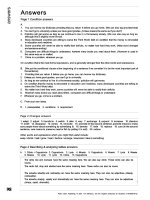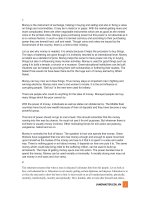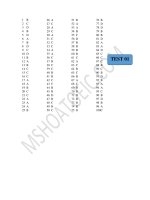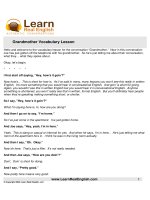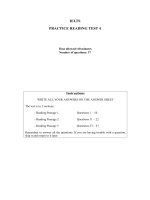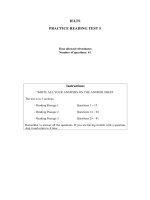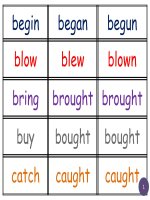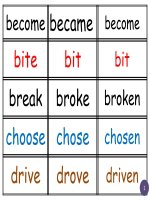cnttqn com TACNCNTT LT english kho tài liệu học tiếng anh
Bạn đang xem bản rút gọn của tài liệu. Xem và tải ngay bản đầy đủ của tài liệu tại đây (841.44 KB, 71 trang )
UỶ BAN NHÂN DÂN TỈNH THANH HÓA
TRƯỜNG ĐẠI HỌC HỒNG ĐỨC
KHOA CÔNG NGHỆ THÔNG TIN – TRUYỀN THÔNG
BÀI GIẢNG
TIẾNG ANH CHUYÊN
NGÀNH CNTT
THANH HÓA, 2015
BÀI GIẢNG
TIẾNG ANH CHUYÊN NGÀNH CNTT
UNIT 1: THE COMPUTER
I. MỤC ĐÍCH CỦA BÀI HỌC
Trong bài này chúng ta sẽ học:
-
Từ vựng chuyên ngành liên quan trong bài.
-
Nắm được ý chính của các bài khóa
-
Làm quen với cách liên kết và bố cục của một đoạn văn bản
-
Luyện tập kỹ năng nói theo tình huống hội thoại trong bài
II. NỘI DUNG BÀI HỌC
1. Từ vựng chuyên ngành
Accumulator
(n)
Tăng
Addition
(n)
Phép cộng
Address
(n)
Địa chỉ
Appropriate
(a)
Thích hợp
Arithmetic
(n)
Số học
Capability
(n)
Khả năng
Circuit
(n)
Mạch
Complex
(a)
Phức tạp
Component
(n)
Thành phần
Computer
(n)
Máy tính
Computerize
(v)
Tin học hóa
Convert
(v)
Chuyển đổi
Data
(n)
Dữ liệu
Decision
(n)
Quyết định
Demagnetize
(v)
Khử từ hóa
Device
(n)
Thiết bị
Disk
(n)
Đĩa
Division
(n)
Phép chia
Electronic
(n,a)
Điện tử, có liên quan đến điện
Equal
(a)
Phép bằng
Exponentiation
(n)
Lũy thừa, hàm mũ
External
(a)
Ngoài, bên ngoài
3
Feature
(n)
Thuộc tính
Firmware
(n)
Phần mềm được cứng hóa
Function
(n)
Hàm, chức năng
Fundamental
(a)
Cơ bản
Greater
(a)
Lớn hơn
Handle
(v)
Giải quyết, xử lý
Input
(v,n)
Vào, nhập vào
Instruction
(n)
Chỉ dẫn, lệnh
Internal
(a)
Trong, bên trong
Intricate
(a)
Phức tạp
Less
(a)
Ít hơn
Logical
(a)
Một cách logic
Magnetic
(a)
Từ
Magnetize
(v)
Từ hóa, nhiễm từ
Manipulate
(n)
Xử lý
Mathematical
(a)
Toán học, hoặc có tính chất toán học
Mechanical
(a)
Cơ khí, có tính chất cơ khí
Memory
(n)
Bộ nhớ
Microcomputer
(n)
Máy siêu vi tính
Microprocessor
(n)
Bộ vi xử lý
Minicomputer
(n)
Máy tính mini
Multiplication
(n)
Phép nhân
Numeric
(a)
Số học, thuộc về số học
Operation
(n)
Thao tác
Output
(v,n)
Ra, đưa ra
Perform
(v)
Tiến hành, thi hành
Process
(v)
Xử lý
Processor
(n)
Bộ xử lý
Pulse
(n)
Xung
Register
(v,n)
Thanh ghi, đăng kí
Signal
(n)
Tín hiệu
Solution
(n)
Giải pháp, lời giải
Store
(v)
Lưu trữ
4
Subtraction
(n)
Phép trừ
Switch
(n)
Chuyển
Tape
(v,n)
Ghi băng, băng
Terminal
(n)
Máy trạm
Transmit
(v)
Truyền
2. Các ý chính trong bài
- Computers are machines capable of processing and outputting data.
- All computers accept and process information in the form of instructions and
characters.
- The information necessary for solving problems is found in the memory of the
computer.
- Computers can still be useful machines even if they can’t communicate with the
user.
- There are many different devices used for feeding information into a computer.
- There aren’t many diferent types of devices used for giving results as there are
for accepting information.
- Computers can work endlessly without having to stop to rest unless there is a
breakdown.
Bài khoá:
Computer is a machine with an intricate network of electronic circuits that operate
switches or magnetize tiny metal cores. The I switches, like the cores, are capable of being
in one of two possible I states, that is, on or off; magnetized or demagnetized. The machine
is capable of storing and manipulating numbers, letters, and characters.The basic idea of a
computer is that we can make the machine do what we want by inputting signals that turn
certain switches on and turn others off, or that magnetize or do not magnetize the cores.
The basic job of computers is the processing of information. For this reason,
computer can be defined as devices which accept information in the form of instructions
called a program and characters called data, perform mathematical and/or logical
operations on the information, and then supply results of these operations. The program, or
part of it, which tells the computers what to do and the data, which provide the information
needed to solve the problem, are kept inside the computer in a place called memory.
Computers are thought to have many remarkable powers. However, most
computers, whether large or small have three basic capabilities. First, computers have
circuits for performing arithmetic operations, such as: addition, subtraction, division,
multiplication and exponentiation. Second, computers have a means of communicating
with the user. After all, if we couldn't feed information in and get results back, these
5
machines wouldn't be of much use. However,. certain computers (commonly
minicomputers and microcomputers) are used to control directly things such as robots,
aircraft navigation systems, medical instruments, etc.
Some of the most common methods of inputting information are to use punched
cards, magnetic tape, disks, and terminals. The computer's input device (which might be a
card reader, a tape drive or disk drive, depending on the medium used in inputting
information) reads theinformation into the computer.
For outputting infonnation, two common devices used are a printer which prints the
new information on paper, or a CRT display screen which shows the results on a TV-like
screen.
Third, computers have circuits which can make decisions. The kinds of decisions
which computer circuits can make are not of the type: "Who would win a war between two
countries?" or "Who is the richest person in the world?" Unfortunately, the computer can
only decide three things, named: Is one number less than another? Are two numbers equal?
and, Is one number greater than another?
A computer can solve a series of problems and make hundreds, even thousands, of
logical decisions without becoming tired or bored. It can find the solution to a problem in a
fraction of the time it takes a human being to do the job. A computer can replace people in
dull, routine tasks, but it has no originality; it works according to the instructions given to it
and cannot exercise any value judgements. There are times when a computer seems to
operate like a mechanical "brain", but its achievements are limited by the minds of human
beings. A computer cannot do anything unless a person tells it what to do and gives it the
appropriate infonnation; but because electric pulses can move at the speed of light, a
computer can carry out vast numbers of arithmeticlogical operations almost
instantaneously. A person can do everything a computer can do, but in many cases that
person would be dead long before the job was finished.
a. Main idea
Which statement best expresses the main idea of the text? Why did you eliminate
the other choices?
1. Computers have changed the way in which many kinds of jobs are done.
2. Instructions and data must be given to the computer.
3. Computers are machines capable of processing and outputting data.
4. Without computers, many tasks would take much longer to do.
b. Understanding the passage
Decide whether the following statements are true or false (T/F) by referring
to the information in the text. Then make the necessary changes so that the false
statements become true.
6
1. A computer can store or handle any data even if it hasn't received information to
do so.
2. All computers accept and process information in the form of instructions and
characters.
3. The information necessary for solving problems is found in the memory of the
computer.
4. Not all computers can perform arithmetic operations, make decisions, and
communicate in some ways with the users.
5. Computers can still be useful machines even if they can't communicate with
the users.
6. There are many different devices used for feeding information into a
computer.
7. There aren't as many different types of devices used for giving results as there
are for accepting information.
8. Computers can make any type of decisions they are asked to do.
9. Computers can work endlessly without having to stop to rest unless there is a
breakdown.
3. Ngữ pháp:
Trong Tiếng Anh các đại từ it, they, them, I, he, she và các đại từ quan hệ which,
who, whose, that, such, that, one được sử dụng để diễn tả các từ trước đó. Nó được sử dụng
như những từ thay thế để tránh việc lặp lại từ trong một đoạn văn ngắn. Ngoài ra còn có các
từ sau:
the former (cái được nhắc tới trước), the latter (cái nhắc tới sau)
the first (cái đầu tiên), the second (cái thứ hai)v.v.. the last (cái cuối cùng)
Bây giờ bạn hãy xem lại bài khoá rồi tìm các từ và cụm từ được ám chỉ tới
1. that operate switches
2. which accept information
3. or part of it
4. which tells the computer
5. which prints the new information
6. which shows the results
7. which can make decisions
8. it can be find the solution
9. it has no originality
7
10. tells it what to do
4. Nâng cao:
Input-process-output
Processing systems accomplish a task: they take one or more inputs and carry out a
process to produce one or more outputs. An input is something put into the system, a
process is a series of' actions or changes carried out by the system, while an output is
something taken from the system.
III. Hội thoại
Dialogue 1: Buying your first computer.
Pair work. Practice the conversation.
Minh: Hi Hương. How's it going?
Hương: Pretty good. I'm going to buy a new computer this afternoon.
Minh: What kind are you going to buy?
Hương: I think I'll buy a desktop, maybe a FPT or DELL.
Minh: Those are very popular in Vietnam, and the prices are really coming down.
Dialogue 2: Printer problems
Pair work. Practice the conversation.
Linh: I finished my report, but the printer is
broken. What can I do?
Hùng: Save the file on a floppy and bring it to
my house. We can use my printer.
Linh: That's a great idea.
Hùng: Or, email it to me - that might be faster.
Linh: Hmm, that won't work. The report has
graphs *
* Is this really true? How can you send pictures
by Email?
Lecture: the roots of the Internet: where it is now, what the future might bring.
Many people have heard the word "Internet", but what is it? A computer network is
8
a group of computers linked together so they can share data. The Internet is the linking of
the thousands of computer networks around the world. It started in the 1970s in the US as a
military program. Today, more than 120 countries and 60 million people use the Internet.
Dialogue 3: CD-ROMs and games
Pair work. Practice the conversation.
Phương: Should I get a CD-ROM with my new computer?
Hà: Of course. All the good game software now comes on CDs
Phương: CDs are also good for multi-media software.
Hà: Yeah. I love playing Age of Empires.
Phương: I hear Diablo is even better.
IV. Bài tập củng cố
1. Write down whether the following statements are true or false.
1. Computers can think. .
2. All systems are made up of groups of elements.
3. Computers can remember a set of instructions.
4. Computers make few mistakes.
5. A computer does not learn from past experiences.
6. Output is something put into the system.
7. A computer was first developed to perform numerical calculations.
8. Computers are human.
9. Our modern society is dependent on computers.
10. Computers hate people.
2. Chia động từ trong ngoặc
1. Various terminals (connect)
to this workstation.
2. Microcomputers (know) as 'PUs'.
3. Magazines (typeset)
by computers.
4. When a particular program is run, the data (process) .................by the computer
very rapidly
5. Hard disks (use) for the permanent storage of information.
9
6. The drug-detecting test in the Tour de France (support)…… by computers.
7. All the activities of the computer system (coordinate) .................by the central
processing unit.
8. In some modern systems information (hold) in optical disks.
3. Translate the text into Vietnamese
What can computers do?
Computers and microchips have become part of our everyday lives: we visit shops
and offices which have been designed with the help of computers, we read magazines which
have been produced on computer, we pay bills prepared by computers. Just picking up a
telephone and dialling a number involves the use of a sophisticated computer system, as does
making a flight reservation or bank transaction.
We encounter daily many computers that spring to life the instant they're switched on
(e.g. calculators, the car's electronic ignition, the timer in the microwave, or the programmer
inside the TV set), all of which use chip technology.
What makes your computer such a miraculous device? Each time you turn it on, it is a
tabula rasa that, with appropriate hardware and software, is capable of doing anything you
ask. It is a calculating machine that speeds up financial calculations. It is an electronic filing
cabinet which manages large collections of data such as customers' lists, accounts, or
inventories. It is a magical typewriter that -allows you to type and print any kind of document
- letters, memos or legal documents. It is a personal communicator that enables you to
interact with other computers and with people around the world. If you like gadgets and
electronic entertainment, you can even use your PC to relax with computer games.
V. Tóm tắt nội dung bài học
Trong bài này chúng ta đã học những nội dung sau:
- Computers are machines capable of processing and outputting data.
- All computers accept and process information in the form of instructions and
characters.
- Trong Tiếng Anh các đại từ it, they, them, I, he, she và các đại từ quan hệ which,
who, whose, that, such, that, one được sử dụng để diễn tả các từ, cụm từ đã xuất
hiện trướ đó. Việc sử dụng những từ thay thế nhằm tránh việc lặp lại các từ trong
đoạn văn ngắn.
- Học tình huống mua máy tính với cấu trúc: What kind are you going to buy?
- Biết thêm được khái niệm đầu vào – xử lý – đầu ra.
10
UNIT 2: HISTORY OF COMPUTER
I. Mục đích bài học
Trong bài này chúng ta sẽ học:
- Tӯ vựng chuyên ngành liên quan trong bài.
- Nắm được các ý chính của bài
- Làm quen với hậu tố trong tiếng Anh.
- Luyện tập kỹ năng nói thông qua các đoạn hội thoại của bài.
II. Nội dung bài học
1. Từ vựng chuyên ngành
Abacus
(n)
Bàn tính
Allocate
(v)
Phân phối
Analog
(n)
Tương tự
Application
(n)
Ứng dụng
Binary
(a)
Nhị phân, thuộc nhị phân
Calculation
(n)
Tính toán
Command
(v,n)
Ra lệnh, Lệnh (trong máy tính)
Dependable
(a)
Có thể tin cậy được
Devise
(v)
Phát minh
Different
(a)
Khác biệt
Digital
(a)
Số, thuộc về số
Etch
(v)
Khắc axit
Experiment
(v,n)
Tiến hành thí nghiệm, thí nghiệm
Figure out
(v)
Tính toán, tìm ra
Generation
(n)
Thế hệ
History
(n)
Lịch sử
Imprint
(v)
In, khắc
Integrate
(v)
Tích hợp
Invention
(n)
Phát minh
Layer
(n)
Tầng, lớp
Mainframe computer
(n)
Máy tính lớn
11
Mathematician
(n)
Nhà toán học
Microminiaturize
(v)
Vi hóa
Multi-task
(n)
Đa nhiệm vụ
Multi-user
(n)
Đa người dùng
Operating system
(n)
Hệ điều hành
Particular
(a)
Đặc biệt
Predecessor
(n)
Người tiền nhiệm, vật tiền nhiệm
Priority
(n)
Sự ưu tiên
Productivity
(n)
Hiệu suất
Real-time
(a)
Thời gian thực
Schedule
(v,n)
Lịch, lập lịch
Similar
(a)
Giống
Storage
(n)
Lưu trữ
Technology
(n)
Công nghệ
Tiny
(a)
Nhỏ bé
Transistor
(n)
Bóng bán dẫn
Vacuum tube
(n)
Bóng chân không
2. Các ý chính trong bài
- Computers, as we know them today, have gone through many changes.
- Computers have had a very short history.
- The abacus and the fingers are two calculating devices still in use today.
- Charles Babbage, an Englishman, could well be called the father of computers.
- The first computer was invented and built in USA.
- Today’s computers have more circuits than previous computers.
Bài khoá:
Let us take a look at the history of the computer that we know today. The very first
calculating device used was the ten ftngers of a man's hands. This, in fact, is why today we
still count in tens and multiples of tens. Then the abacus was invented, a bead frame in
which the beads are moved from left to right. People went on using some form of abacus
well into the 16th century, and it is still being used in some parts of the world because it
can be understood without knowing how to read.
12
During the 17 th and 18th centuries many people tried to ftnd easy ways of
calculating. J.Napier, a Scotsman, devised a mechanical way of multiplying and dividing,
which is how the modem slide rule works. Henry Briggs used Napier's ideas to produce
logarithm tables which all mathematicians use today. Calculus, another branch of
mathematics, was independently invented by both Sir Isaac Newton, an Englishman, and
Leibnitz, a German mathematician.
The first real calculating machine appeared in 1820 as the result of several people's
experiments. This type of machine, which saves a great deal of time and reduces the
possibility of making mistakes, depends on a series of ten-toothed gear wheels. In 1830
Charles Babbage, an Englishman, designed a machine that was called "The Analytical
Engine". This machine, which Babbage showed at the Paris Exhibition in 1855, was an
attempt to cut out the human being altogether, except for providing the machine with the
necessary facts about the problem to be solved. He never finished this work, but many of
his ideas were the basis for building today's computers.
In 1930, the first analog computer was built by an American named Vannevar Bush.
This device was used in W orld War II to help aim guns. Mark I, the name given to the ftrst
digital computer, was completed in 1944. The men responsible for this invention were
Professor Howard Aiken and some people from IBM. This was the first machine that could
figure out long lists of mathematical problems, all at a very fast rate. In 1946 two engineers
at the University of Pennsylvania, J. Eckert and J. Mauchly, built the first digital computer
using parts called vacuum tubes. They named their new invention ENIAC. Another
important advancement in computers came in 1947, when John Yon Newmann developed
the idea of keeping instructions for the computer inside the computer's memory.
The first generation of computers, which used vacuum tubes, came out in 1950.
Univac I is an example of these computers which could perform thousands of calculations
per second. In 1960, the second generation of computers was developed and these could
perform work ten times faster than their predecessors. The reason for this extra speed was
the use of transistors instead of vacuum tubes. Second-generation computers were smaller,
faster and more dependable than fIrst- generation computers. The third-generation
computers appeared on the market in 1965. These computers could do a million
calculations a second, which is 1000 times as many as first generation computers. Unlike
second-generation computers, these are controlled by tiny integrated circuits and are
consequently smaller and more dependable. Fourth-generation computers have now
arrived, and the integrated circuits that are being developed have been greatly reduced in
size. This is due to microminiaturization, which means that the circuits are much smaller
than before; as many as 1000 tiny circuits now fit onto a single chip. A chip is a square or
rectangular piece of silicon, usually from 1/10 to 1/4 inch, upon which several layers of an
integrated circuit are etched or imprinted, after which the circuit is encapsulated in plastic,
ceramic or metal. Fourth-generation computers are 50 times faster than third - generation
computers and can complete approximately 1,000,000 instructions per second.
13
At the rate computer technology is growing, today's computers might be obsolete
by 1985 and most certainly by 1990. It has been said that if transport technology had
developed as rapidly as computer technology, a trip across the Atlantic Ocean today would
take a few seconds.
a. Main idea
Which statement best expresses the main idea of the text? Why did you eliminate the
other choices?
1. Computers, as we know them today, have gone through many changes.
2. Today's computer probably won't be around for long.
3. Computers have had a very short history.
b. Understanding the passage
Decide whether the following statements are true or false (T/F) by referring
to the information in the text. Then make the necessary changes so that the false statement
become true.
1. The abacus and the fingers are two calculating devices still in use today.
2. The slide rule was invented hundreds of years ago.
3. During the early 1880s, many people worked on inventing a mechanical
calculating machine.
4. Charles Babbage, an Englishman, could well be called the father of computers.
5. The first computer was invented and built in the USA.
6. Instructions used by computers have always been kept inside the computer's
memory.
7. Using transistors instead of vacuum tubes did nothing to increase the speed at
which calculations were done.
8. As computers evolved, their size decreased and their dependability
increased.
9. Today's computers have more circuits than previous computers.
10. Computer technology has developed to a point from which new developments in
the field will take a long time to come.
3. Ngữ pháp:
Trong Tiếng Anh, các hậu tố sau thường xuất hiện:
- Để trở thành các danh từ: ance, ence, or, er, ist, ness.
- Để trở thành các động từ: ize, ate, fy, en, ify.
- Để trở thành các tính từ: able, ible, less, ic, ical, ish, ive
14
- Để trở thành các phó từ: ly
Điền vào khoảng trống dạng đúng của các từ sau
1. operation, operate, operator, operational, operationally, operating
a. A computer can perform mathematical ...... very quickly.
b. One of the first persons to note that the computer is malfunctioning is the computer
......
c. The job of a computer operator is to ......... the various machines in a
computer installation.
d. The new machines in the computer installation are not yet ........
2. acceptance, accept, accepted, acceptable, acceptably
a. A computer is a device which ...... processes and gives out information.
b. The students are still waiting for their ..... into the Computer Science program.
c. It is ..... to work without a template if the flowcharts are not kept on file.
4. Nâng cao:
Refinement and synthesis
Refining a system means analysing it in more detail and breaking it down into
smaller components. Each part of the process may be considered either as a system in
itself, or as a sub- system. A sub-system is a small system which is part of a larger system.
It also contains a group of elements which work together to achieve a purpose.
Synthesis is the reverse process; it involves combining simple sub-systems into a
larger, more complex system.
III. Hội thoại:
Dialogue 1 - Jim is at a store buying a computer.
Pair work. Practice the conversation.
Nhân viên bán máy: May I help you?
Hùng: Yes, I want to buy a new computer.
Nhân viên bán máy: How much RAM do you need? How big a hard drive will
you need?
Hùng:Well, Windows 95 needs at least 32 MBs RAM, and I'll be using a lot of
word processors and game programs.
Nhân viên bán máy: I recommend a Pentium 300 with an 8 GB hard drive.
Pair work: What kind of computer do you want? If you have a computer, what do you
15
have?
Dialogue 2:
Pair work. Practice the conversation.
Minh: Does this desktop come with a monitor?
Nhân viên bán hàng: Yes, a 15 inch monitor is included, but I suggest buying a 17
inch one instead.
Minh: What kind of sound card does it have?
Nhân viên bán hàng: It has a Sound Blaster 16.
Group work: Discussion - What kind of computers have you used?
Reading:
When only a few computers are hooked together, usually in a single office or
building, the result is called a Local Area Network (LAN). When the computers are
connected over a greater distance, for example sales offices throughout a city, the result is
called a Wide Area Network (WAN). Connecting all of these LANs and WANs together
results in an Internet. The Internet is the world wide connection of all different kinds of
networks. A new kind of network is emerging for businesses called an intranet. This refers
to all the computers in a company sharing data using the same kind of system as the
Internet.
IV. Bài tập củng cố
1. Điền các từ, cụm từ vào chỗ trống
the various parts of the program, language, binary numbers, may occur in programs,
a given problem
1 algorithm
The step-by-step specification of how to reach the solution to
..............................................
2 flowchart
A diagram representing the logical sequence between .........................................
3 coding
The translation of the logical steps into a programming …………..................
4 machine code
The basic instructions understood by computers. The processor operates on codes
which consist of ......................................
5 debugging
16
The techniques of detecting, diagnosing and
which ...................................
correcting errors (or 'bugs')
2. Dịch đoạn văn sau ra Tiếng Việt
What does a scanner do?
A scanner converts fext or pictures into electronic codes that can be manipulated by
the computer. In a flatbed scanner, the paper with the image is placed face down on a glass
screen similar to a photocopier. Beneath the glass are the lighting and measurement
devices. Once the scanner is activated, it reads the image as a series of dots and then
generates a digitized image that is sent to the computer and stored as a file. The
manufacturer usually includes software which offers different ways of treating the scanned
image.
A colour scanner operates by using three rotating lamps, each of which has a
different coloured fIlter: red, green and blue. The resulting three separate images are
combined into one by appropriate software.
V. Tóm tắt nội dung bài học
Trong bài này chúng ta đã học những nội dung sau:
- Charles Babbage, an Englishman, could well be called the father of computers.
- The first computer was invented and built in USA.
Các hậu tố sau thường xuất hiện:
- Để trở thành các danh từ: ance, ence, or, er, ist, ness.
- Để trở thành các động từ: ize, ate, fy, en, ify.
- Để trở thành các tính từ: able, ible, less, ic, ical, ish, ive
- Để trở thành các phó từ: ly
17
UNIT 3: CHARACTERISTICS OF COMPUTER
I. Mục đích bài học
Trong bài này chúng ta sẽ học
- Từ vựng chuyên ngành liên quan trong bài.
- Nắm được ý chính của bài khoá.
- Làm quen với cách sắp xếp liên từ và bố cục của một đoạn văn.
- Luyện tập kỹ năng nói thông qua tình huống hội thoại trong bài.
II. Nội dung bài học
1. Từ vựng chuyên ngành
Ability
(a)
Khả năng
Access
(v,n)
Truy cập; sự truy cập
Acoustic coupler
(n)
Bộ ghép âm
Analyst
(n)
Nhà phân tích
Centerpiece
(n)
Mảnh trung tâm
Channel
(n)
Kênh
Characteristic
(n)
Thuộc tính, nét tính cách
Cluster controller
(n)
Bộ điều khiển chùm
Consist (of)
(v)
Bao gồm
Convert
(v)
Chuyển đổi
Equipment
(n)
Trang thiết bị
Gateway
(n)
Cổng kết nối cho những mạng lớn
Interact
(v)
Tương tác
Limit
(v,n)
Hạn chế
Merge
(v)
Trộn
Multiplexor
(n)
Bộ dồn kênh
Network
(n)
Mạng
Peripheral
(a)
Ngoại vi
Reliability
(n)
Sự có thể tin cậy được
Single-purpose
(n)
Đơn mục đích
Teleconference
(n)
Hội thoại từ xa
Tremendous
(a)
Nhiều, to lớn, khủng khiếp
18
2. Các ý chính trong bài
- All computers have an input, a processor, an output and a storage device.
- All computers have the same basic hardware components.
- All information to be processed must be prepared in such a way that the computer
will understand it.
- Because of the complex electronic circuitry of a computer, data can be either stored
or moved about at high speeds.
- The processor is the central component of a computer system.
- All other devices used in a computer system are attached to the CPU.
- Memory devices are used for storing information.
Bài khoá
Corpputers are machines designed to process, electronically, specially prepared
pieces of information which are termed data. Handling or manipulating the information
that has been given to the computer, in such ways as doing calculations, adding
information or making comparisons is called processing. Computers are made up of
millions of electronic devices capable of storing data or moving them, at enormous speeds,
through complex circuits with different functions.
All computers have several characteristics in common, regardless of make or
design. Information, in the form of instructions and data, is given to the machine, after
which the machine acts on it, and a result is then returned. The information presented to the
machine is the input; the internal manipulative operations, the processing; and the result,
the output. These three basic concepts of input, processing, and output occur in almost
every aspect of human life whether at work or at play. For example, in clothing
manufacturing, the input is the pieces of cut cloth, the processing is the sewing together of
these pieces, and the output is the finished garment.
INPUT
COMPUTER
OUTPUT
SEC.STORAGE
Figure shows schematically the fundamental hardware components in a computer
system. The centerpiece is called either the computer, the processor, or usually, the central
processing unit (CPU). The term "computer" includes those parts of hardware in which
calculations and other data anipulations are performed, and the high-speed internal memory
19
in which data and calculations are stored during actual execution of programs. Attached to
the CPU are the various peripheral devices such as card reader and keyboards (two
common examples of input devices). When data or program need to be saved for long
period of time, they are stored on various secondary memory devices of storage devices
such a magnetic tapes or magnetic disks.
Computers have often been thought of as extremely large adding machines, but this
is a very narrow view of their function. Although a computer can only respond to certain
number of instructions, it is not a single-purpose machine since these instructions can be
combined in an infinite number of sequences. Therefore, a computer has no known limit on
the kinds of things it can do; its versatility is limited only by the imagination of those using
it.
In the late 1950s and early 1960s when electronic computers of the kind in use
today were being developed, they were very expensive to own and run. Moreover, their
size and reliability were such that a large number of support personnel were needed to keep
the equipment operating. This has all changed now that computing power has become
portable, more compact, and cheaper.
In only a very short period of time, computers have greatly changed the way in
which many kinds of work are performed. Computers can remove many of the routine and
boring tasks from our lives, thereby leaving us with more time for interesting, creative
work. It goes without saying that computers have created whole new areas of work that did
not exist before their development.
a. Main idea
Which statement best expresses the main idea of the text? Why did you eliminate
the other choices?
1. Computers have changed the way in which we live.
2. All computers have an input, a processor output and a storage device.
3. Computers have decreased man's workload.
4. All computers have the same basic hardware components.
b. Understanding the passage
Decide whether the following statements are true or false (T/F) by referring
to the information in the text. Then make the necessary changes so that the false statement
become true.
1. All information to be processed must be prepared in such a way that the
computer will understand it.
2. Because of the complex electronic circuitry of a computer, data can be either
stored or moved about at high speeds.
3. Not all computers can process data given to them and produce results.
20
4. The basic concepts of data processing are restricted to computers alone.
5. The processor is the central component of a computer system.
6. All other devices used in a computer system are attached to the CPU.
7. Memory devices are used for storing information.
8. Computers are very much restricted in what they can do.
9. Computers today cost less, are smaller, and need fewer people to operate them
than in the past
10. Computers haven't changed our working conditions very much
3. Ngữ pháp:
Một đoạn văn là một nhóm các câu được liên kết với nhau để phát triển một ý. Hầu
như trong tất cả các đoạn văn, có một ý quan trọng, đó là ý chính của đoạn văn và thường
là câu đầu tiên của mỗi đoạn văn. Người ta gọi là câu chủ đề (topic sentence). Ngoài ra còn
có các ý phân tích chi tiết hơn trong các câu sau của đoạn văn.
Bây giờ bạn hãy quay lại đọc bài khoá để tim các câu chủ đề và các câu phát triển ý của
từng đoạn văn rồi so sánh với kết quả trong phần gợi ý chính ở mục 2.
4. Nâng cao:
A black box
Many people do not understand how a system works, yet they know that if the
system is given a certain input it will produce a certain output. For example, in a recorded
music system when a CD is placed in the CD player and the play button is pressed, the
music will be heard. Most people are not concerned with how the CD player works. A
system such as this can be called a 'black box' because the internal components of the
system are not fully understood by most people. Their main concern is that the system
accomplishes its task.
III. Hội thoại
Dialogue 1:
Jim gets the new computer home, turns it on, and nothing happens.
Pair work. Practice the conversation.
Linh: Hey Hưng, that's a nice computer.
Hưng: Yeah, but it doesn't work. Look, I turn on
the monitor, turn on the computer, and nothing happens.
Linh: Are all the cables plugged in?
Hưng: Yes, and I read the manual three times. I
21
don't understand!
Linh: Let me look at it. Oh, here you are - you
didn't plug it in..
Hưng: Oh no....
Dialogue 2:
Pair work. Practice the conversation.
Mai: What's in these boxes?
Long: The big one is my scanner and the
little ones are my speakers and modem.
Mai: You sure bought a lot of peripherals.
Long: Well, I still want to buy a laser jet printer.
IV. Bài tập củng cố
1) Điền từ vào chỗ trống
create, publish, become, be, come out, give, develop, have, find, test, offer, take.
The PostScript language (1)…………in the early 1980s as a page description
language for printers and photosetters. It was Adobe Systems, Inc. that
(2)………………the PostScript
language and developed Illustrator, the first program that (3)……………………..:
advantage of the full range of graphic possibilities (4)……..by PostScript. Adobe Systems
(5)………….also the suppliers of fonts for use with PostScript-based printers.
The language was documented in The PostScript Language Reference Manual,
(6)…………by Addison-Wesley in 1985. PostScript soon (7)………………….widely used
by DTP publishers and graphic designers. In 1990 PostScript level 2 (8)……………, which
incorporated new features such as ATM technology, composite fonts, image compression
and other details.
When some experts (9) the performance of different colour printers, they
(10)……….that every PostScript printer was easy to use and (11) …………..consistently
good results, while every non-PostScript printer (12)……………problems with output in at
least one application.
2) Dịch đoạn văn sau sang tiếng Việt
When buying a hard disk
Hard disks have important advantages over floppy disks: they spin at a higher
speed, so you can store and retrieve information much faster than with floppies. They can
22
also hold vast amounts of information, from 500 MB up to several gigabytes. Apart from
this, both types of disks work in the same way. To directly access the necessary
information, the read/write heads of rigid disks seek the required tracks and sectors, and
then transfer the information to the main memory" of the computer or to another I form of
storage, all of which is done in a few milliseconds (ms).
Bearing in mind that you always need disk storage, it is good sense to ask yourself
some vital questions: What size capacity do I need? What speed can I use? What kind of
storage device is the most suitable for my requirements? If you only use word-processing
programs, you will need less storage capacity than if you use CAD, sound and animation
programs. For most users, 2GB on the hard disk is enough.
Now let's turn our attention to speed. Access times vary from 8 ms to 20 ms. Access
time - or seek time - is the time it takes your read/write heads to find any particular record.
You have to distinguish clearly between seek time (e.g. 20 ms) and 'data I transfer rate' (the
average speed required to transmit data from a disk system to the RAM, e.g. at 20 megabits
per second). Remember that the transfer rate also depends on the power of your computer.
When buying a hard disk you should consider the kinds of drive mechanisms and
products available. There are 'internal' and 'external' drives which are both fixed hard
drives, i.e. rigid disks sealed into the drive unit, either within or attached to the computer. A
third type of hard drive, known as 'removable', allows information to be recorded on
'cartridges', which can be removed and stored offline for security purposes. Popular
removable hard disks include Jaz and Zip drives. A Jaz cartridge can store up to 2 GB of
data, whereas a Zip drive can store up to 250 MB of data.
Finally, a few words about 'optical' technology: CD-ROMS and CD-Recordable
drives have become a reality. However, magnetic hard disks are still preferred for personal
data storage, whereas optical disks are used for recording large amounts of information
such as a dictionary or ehcyclopedia.
V. Tóm tắt nội dung bài học
Trong bài này chúng ta đã hӑc những nӝi dung sau:
- All computers have an input, a processor, an output and a storage device.
- All computers have the same basic hardware components.
- All information to be processed must be prepared in such a way that the computer
will understand it.
- Một đoạn văn là một nhóm các câu được liên kết với nhau để phát triển một ý. Hầu
như tất các các đoạn văn có một ý quan trọng, đó là ý chính của đoạn văn và
thường là câu đầu tiên của mỗi đoạn văn. Người ta gọi là câu chủ đề (topic
sentence).
- Cách lắp máy tính với các cấu trúc: turn on the monitor, plug in the cable, read the
manual.
23
UNIT 4: HARDWARE AND SOFTWARE
I. Mục đích bài học
Trong bài này chúng ta sẽ học:
-
Từ vựng chuyên ngành liên quan trong bài.
-
Nắm được ý chính của bài khoá.
-
Làm quen với các tiền tố trong tiếng Anh.
-
Luyện tập kỹ năng nói thông qua các tình huống trong bài.
II. Nội dung bài học
1. Từ vựng chuyên ngành
Activity
(n)
Hoạt động
Animation
(n)
Hoạt hình
Attach
(v)
Gắn vào, đính vào
Condition
(n)
Điều kiện
Coordinate
(v)
Phối hợp
Crystal
(n)
Tinh thể
Diagram
(n)
Biểu đồ
Display
(v,n)
Hiển thị; màn hình
Distribute
(v)
Phân phối
Divide
(v)
Chia
Document
(n)
Văn bản
Electromechanical
(a)
Có tính chất cơ điện tử
Encode
(v)
Mã hóa
Estimate
(v)
Ước lượng
Execute
(v)
Thi hành
Expertise
(n)
Sự thành thạo
Graphics
(n)
Đồ họa
Hardware
(n)
Phần cứng
Interchange
(v)
Trao đổi lẫn nhau
Liquid
(n)
Chất lỏng
Magazine
(n)
Tạp chí
24
Majority
(n)
Phần lớn, phần chủ yếu
Multimedia
(n)
Đa phương tiện
Online
(a)
Trực tuyến
Package
(n)
Gói
Physical
(a)
Thuộc vật chất
Recognize
(v)
Nhận ra, nhận diện
Secondary
(a)
Thứ cấp
Service
(n)
Dịch vụ
Software
(n)
Phần mềm
Solve
(v)
Giải quyết
Sophistication
(n)
Sự phức tạp
Superior (to)
(a)
Hơn, trên, cao hơn…
Task
(n)
Nhiệm vụ
Text
(n)
Văn bản chữ bao gồm ký tự
2. Các ý chính trong bài
-
A computer system needs both hardware and software to be complete.
-
A system implies a good mixture of parts working together.
-
The computer is the hardware.
-
The processor is usually referred to as the CPU.
-
The computer means the processor and the internal memory.
-
Systems software is usually referred to as programs.
-
Complete software/hardware products are called turnkey systems.
-
Computers process specially prepared items of information.
Bài khoá:
In order to use computers effectively to solve problems in our environment,
computer systems are devised. A "system" implies a good mixture of integrated parts
working together to form a useful whole. Computer systems may be discussed in two parts.
The first part is hardware - the physical, electronic and electromechanical devices
that are thought and recognized as "computers". The second part is software - the programs
that control and coordinate the activities of the computer hardware and that direct the
processing of data.
25

